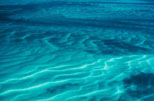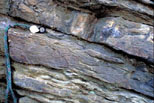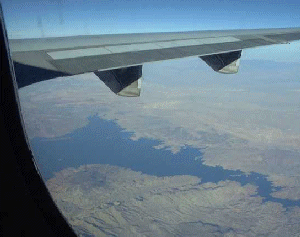Sedimentary Rocks Contain Clues to Ancient Environments
As climate changes over time, so do the environments that are present in a
region. For instance, at one time a region might contain a vast lake
and river
system, but millions of years later there may be no trace of water
at all. While water may have left the region, traces of the lake and rivers
might remain in the sediment that was deposited
by the water and the shape of the landscape as well. These traces allow us to
figure out what environments were like in the past!
Different types of environments contain different types of sediments. The type
of sediment and the way that it is deposited determines the types of sedimentary
rocks that will eventually be formed. Thus, sedimentary rocks formed in
a lake will be different from those formed in a desert.
Geologists look at ancient sedimentary rocks to figure out the type of environment
that once was in the location where the rock formed. The table below lists environments
that are common on Earth and the physical features that characterize them. Click
on the pictures below to take a look at environments and the rocks that are
made from them.
| Environment |
Sediment Size |
Sediment Sorting |
Structures and Features |
The Environment Today: |
Evidence Preserved in Rock: |
| Lake |
Mud |
Fair |
- Thin layers called laminations
- Sometimes mud cracks
|
 |
 |
| Swamp |
Mud |
|
- Organic material makes coal
|
 |
 |
| Desert Dunes |
Sand |
Very good |
- Cross-beds
- Rounded grains
|
 |
 |
| Alluvial Fan |
Sand and gravel |
Poor |
- Angular fragments of rock
|
 |
 |
| River |
Silt, sand, and gravel |
Poor |
- Rounded pebbles, channel shape
- Cross-beds and ripple marks
|
 |
 |
| Lagoon |
Mud |
|
- Mud cracks and ripple marks
|
 |
 |
| Beach |
Silt, sand, or gravel |
Good |
- Mud cracks and ripple marks
- Laminations and other thin layers
|
 |
 |
| Shallow Ocean |
Silt and sand |
Good |
- Thick or thin layers
- ripples and cross-beds
|
 |
 |
| Deep Ocean |
Mud, with thin layers of sand or silt |
Fair |
- Layers of mud.
- Thin sand layers form as sediment flows downslope.
|
 |
 |
| Tropical Ocean |
Sediment made of Calcite (and other carbonate minerals) |
Good to poor |
- Most sediment comes from the skeletons of marine life.
|
 |
 |
Last modified January 6, 2004 by Lisa Gardiner.
You might also be interested in:

Rivers are very important to Earth because they are major forces that shape the landscape. Also, they provide transportation and water for drinking, washing and farming. Rivers can flow on land or underground
...more
When water or wind loses energy and slows down, sediment can no longer be carried in it. The particles fall through the water or air and form a blanket of sediment on the bottom of a river, a lake, ocean,
...more
Earth’s climate is warming quickly now. We know that this has to do with additional greenhouse gases in the atmosphere and other global changes. But there is a lot we don’t yet know about how warming will
...more
NASA’s rover, named Spirit, has successfully landed and will soon be scouting the surface of Mars for interesting geology! Scientists are interested to know whether the depression where Spirit landed
...more
Today, the South American jungle is home to many snakes. But 60 million years ago it was home to much larger snakes. Scientists have discovered the fossils of a snake that was longer than a school bus.
...more
Looking for online content that can be used for a climate change education course or module? Pages linked below can be used to support an introductory climate change education for either a unit or a full
...more
Spotting minerals is fun! There are many different types of minerals, each with a different name and a special set of characteristics. So, if you find a mineral that you do not recognize, you can use
...more


































